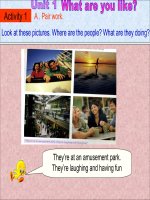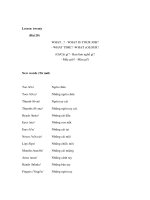- Trang chủ >>
- THPT Quốc Gia >>
- Hóa
What is light like
Bạn đang xem bản rút gọn của tài liệu. Xem và tải ngay bản đầy đủ của tài liệu tại đây (2.41 MB, 10 trang )
Physical Sciences
Standards
Preview
Standard Set 2. Physical Sciences
2. Light has a source and travels in a
direction. As a basis for understanding
this concept:
2.a. Students know sunlight can be
blocked to create shadows.
2.c. Students know the color of light
striking an object affects the way the
object is seen.
2.d. Students know an object is seen
when light traveling from the object
enters the eye.
2.b. Students know light is reflected
from mirrors and other surfaces.
What Is Light
Like?
by Kristin Cashore
Genre
Nonfiction
Comprehension Skill
Predict
Text Features
• Captions
• Diagrams
• Glossary
Science Content
Light
Scott Foresman Science 3.2
ISBN 0-328-23521-0
ì<(sk$m)=cdfcbg< +^-Ä-U-Ä-U
Vocabulary
absorb
color
eye
light
mirror
opaque
reflect
shadow
Picture Credits
Illustration
6 Robert (Bob) Kayganich.
Photographs
Every effort has been made to secure permission and provide appropriate credit for photographic material. The
publisher deeply regrets any omission and pledges to correct errors called to its attention in subsequent editions.
Unless otherwise acknowledged, all photographs are the copyright of Dorling Kindersley, a division of Pearson.
Photo locators denoted as follows: Top (T), Center (C), Bottom (B), Left (L), Right (R), Background (Bkgd).
Opener: ©Paul A. Souders/Corbis; 1 ©Steve Gorton/DK Images.
ISBN: 0-328-23521-0
Copyright © Pearson Education, Inc. All Rights Reserved. Printed in the United States of America.
This publication is protected by Copyright, and permission should be obtained from the publisher prior to any
prohibited reproduction, storage in a retrieval system, or transmission in any form by any means, electronic,
mechanical, photocopying, recording, or likewise. For information regarding permission(s), write to
Permissions Department, Scott Foresman, 1900 East Lake Avenue, Glenview, Illinois 60025.
1 2 3 4 5 6 7 8 9 10 V010 13 12 11 10 09 08 07 06
What Is Light
Like?
by Kristin Cashore
Opaque Objects
What is light,
anyway?
Light is a form of energy. Light travels in straight
lines away from its source. On Earth, we get light from
things such as lightbulbs, lanterns, and candles. But what
is our biggest source of light? The Sun! Light moves
outward from the Sun in all directions. Some of this light
hits Earth.
Light from a candle or a ceiling lamp also moves
outward in all directions. The light from a car headlight,
though, shines in only one direction. The light is blocked
from shining in other directions.
You know that light moves in a straight line. What
does this mean? Light does not bend or turn corners to
get around opaque objects. Opaque objects are objects
that block light.
Light hits objects that are in its way. Some objects
stop light from continuing to move in the same direction.
A car or an airplane is opaque. It blocks light from
traveling in the same direction.
An airplane is an
opaque object.
Light travels
out from a
candle flame
in every
direction.
The Sun is our biggest
source of light.
2
3
Shadows
Sometimes when an object blocks light, it creates
a shadow. A shadow is an area that does not receive
light directly. Think of a tall building on a sunny day.
The building blocks the sunlight. Behind the building, a
shadow forms. Shadows always form behind objects, on
the opposite side from the light source.
Light can make different kinds of shadows. Light
shining above an object makes a shadow that is about the
same size as the object. Light hitting the side of an object
makes a shadow of a different shape and size.
Shadows have different kinds of edges. If an object is
close to the surface where its shadow forms, the shadow
will have sharp edges. The shadow of a person standing
on the sidewalk will have sharp edges.
If an object is far away from the surface where the
shadow forms, the shadow will have fuzzy edges. A bird
flying in the sky will have a shadow with fuzzy edges.
A shadow is formed
when a cup full of
pencils blocks light.
The size and shape of a shadow
depends on where the light is
coming from.
4
5
Seeing with Light
How does your eye see? Your eye is the part of your
body that is sensitive to light energy. Look at the picture
below. First, light enters your eye. It passes through your
eye’s clear covering. It hits the back of your eye, and
forms an upside-down image there.
Next, your eyes sends a signal to your brain. Your
brain flips the image so that it is right-side-up. Your brain
helps you understand what you are seeing.
What happens if an opaque object comes between the
eye and the original object? Put a car in front of a dog.
The car blocks the light coming from the dog. The eye
can no longer see the dog. Can you think of the reason
why? It’s because light travels in a straight line!
The parts of the eye work
together to send an image
to the brain.
The car is an opaque object.
It blocks the light from the original object
from reaching your eye.
6
7
Reflection
You know that light travels in a straight line. What
happens to a line of light when it hits an object? Will it
disappear? No! When light hits an object, some of it will
reflect, or bounce off, the object. The light that reflects
will keep moving in a straight line. But now it will be
moving in a different direction.
Most objects that you see do not make their own
light. Instead, they reflect light. Reflected light allows you
to see. How can you see the cup you are drinking from?
Light from the Sun or another source hits the cup. The
light reflects off the cup. When the reflected light reaches
your eyes, you see the cup.
Why can’t you see anything in a dark room? Because
there is no light reflecting off of the objects in the room!
A mirror reflects the light from the
girl’s flashlight back onto her shirt.
8
9
Mirrors
Other Objects
A mirror is a surface made of shiny material. A
mirror reflects light in a very organized way. When light
from an object reflects from a mirror, the light travels
together in a different direction toward your eye. A
clear image of the object is reflected in the surface of the
mirror.
Most objects do not have shiny surfaces. Look around
your classroom. Desks, chairs, and even people have
uneven surfaces. Light coming from an object that reflects
off an object with rough surfaces is scattered in many
different directions. You cannot see other objects reflected
in an object that has an uneven surface. When you look
at such an object, all you can see is the object.
This flat mirror keeps light from
this person’s face from scattering in
many directions.
The table has a rough surface. You cannot
see anything reflected in its surface.
FPO
10
11
How does color
happen?
Objects in Sunlight
Sunlight is made of many different colors of light.
They combine to form white light. When sunlight hits
most objects, the objects absorb, or take in, some of this
light. The objects reflect the rest of this light. The light
that reflects from an object makes the color of the object.
Think of a red fire engine. When sunlight shines on
the fire engine, the fire engine absorbs all colors of light
except red. The fire engine reflects the red light.
An object looks like the color of the light it reflects.
If an object reflects all colors of light, it will look white
to your eye. If an object absorbs all colors of light, it will
look black to your eye.
Have you ever seen a stained glass window? You can
see some of the colors in sunlight through the window.
Each pane of glass is a different color. So each pane
only lets one color in sunlight go through. The rest is
absorbed. All of these colors are in sunlight! Passing
sunlight through stained glass can create light sources of
different colors.
What colors do these different objects reflect?
12
13
Colors of Light
Sunlight is made of all colors of light. Some lightbulbs
make only one color of light. What happens if a colored
light shines on an object?
The color of light that hits an object can change the
color of the object. Look at the picture of the fountain.
When red light strikes the water, the water reflects red
light. When yellow light strikes the water, the water
reflects yellow light.
When white light hits the colored cups in the picture
below, the yellow cup, for instance, looks yellow. But
what happens if the cups are in colored light? In blue
light, the red cup absorbs the blue light. The cup looks
black. The other cups reflect blue light. These cups look
blue. In red light, the green and blue cups absorb the red
light. The cups look dark gray. The other cups reflect the
red light. They look red. You can see that different colors
of light have different effects on objects.
The color of the water changes depending
on the color that is shining on it.
The green, yellow, red, and
blue cups will appear to have
those colors in white light. The
colors of the cups can change
when different colors of light
shine on them.
14
15
Glossary
What did you learn?
absorb
take in light
1. Why can’t you see an object being blocked by
something opaque?
color
a property of an object determined by
the light that reflects from the object
2. Why can you see the image of an object clearly in a
mirror?
eye
the part of the body that is sensitive to
light energy
light
a form of energy that that can be seen
and that travels in a straight line away
from its source
mirror
a surface made of shiny material
opaque
describes materials that block light
reflect
bounce off, as a light wave does from
an object
shadow
an area that does not receive light
directly
16
3. Sunlight hits a yellow beach ball. What light does the
ball absorb? What light does it reflect?
4.
Go to the encyclopedia and
research the eye. Write a paragraph about how the eye
works. What are the parts of the eye? How do they
work together to help you see?
5.
Predict What will happen if you shine a flashlight
on a table with a rough surface?









